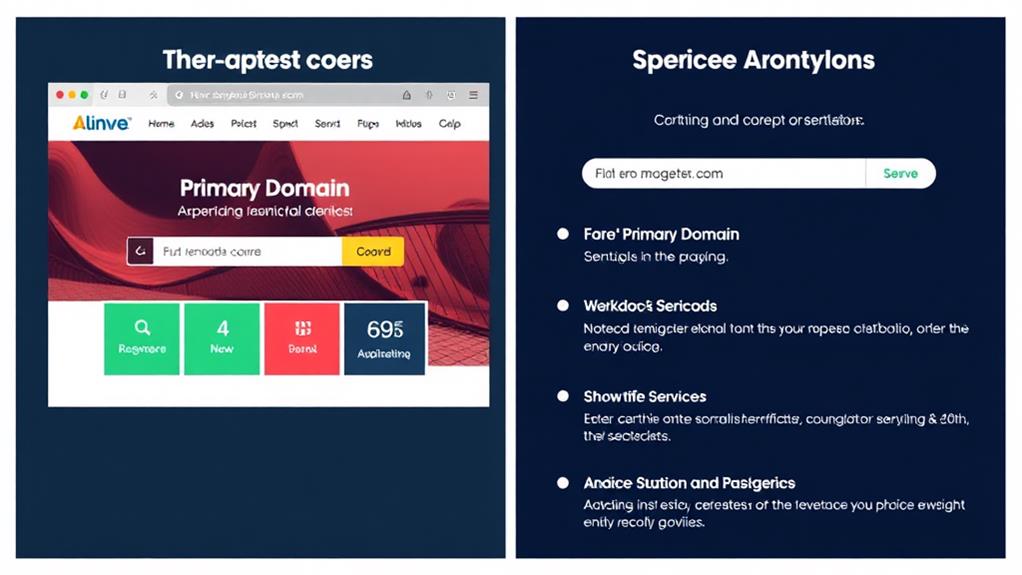When you're comparing a domain and a subdomain, think of your main website as yourcompany.com, while a subdomain is like blog.yourcompany.com. The domain identifies your brand, while subdomains help organize related content, making navigation easier. Each has its own SEO implications; domains consolidate authority, while subdomains may dilute it. You'll also deal with separate technical aspects, like DNS entries and SSL certificates, for subdomains. In short, domains establish your primary online identity, while subdomains enhance structure. Want to learn how to choose between them for your site?
Definitions of Domain and Subdomain
Understanding the differences between a domain and a subdomain is vital for anyone looking to establish an online presence. A domain serves as your main website's primary identity, typically formatted as yourdomain.com. It's the unique website address that users type into their browsers to reach your core site. Without a unique domain name, your online brand can't stand out. Incorporating relevant keywords in your domain name can greatly enhance your website visibility and attract targeted traffic, making it essential for your overall online strategy importance of choosing a relevant domain name.
On the other hand, a subdomain acts as an extension of your domain, formatted as subdomain.yourdomain.com. Subdomains let you create specific sections of your site, enhancing organization and navigation. You might use subdomains for dedicated functions like blogs, support pages, or e-commerce stores, allowing different content management systems to serve various user experiences.
While each domain name must be unique—ensuring no two websites share the same address—you can easily create subdomains under your existing domain without needing to purchase a separate domain. This hierarchy allows your main website to maintain its identity while offering additional, focused areas for visitors.
Purpose of Domains and Subdomains
Serving as the cornerstone of your online presence, domains establish your website's identity and credibility. When you choose a domain name, you're not just picking a unique URL; you're creating a strong brand that resonates with users. A well-chosen domain can enhance your site's visibility and memorability, ultimately influencing user trust and search engine rankings, as highlighted in the importance of domain selection.
Subdomains, on the other hand, allow you to organize your content effectively and serve specific purposes within your main domain.
Here are some key roles domains and subdomains play:
- Identity: Domains define your online identity, making it easy for users to recognize your brand.
- Organization: Subdomains help structure your website, directing users to relevant sections like a blog or store.
- User Experience: By providing targeted content, subdomains enhance user experience without needing separate domain registrations.
- Content Management: With subdomains, you can streamline content management, ensuring each segment of your site is easily navigable.
In essence, your main domain anchors your online identity, while subdomains create a seamless journey for visitors, ensuring they find what they need quickly and efficiently.
Together, they form a powerful combination that elevates your web presence.
Technical Aspects to Consider

When setting up your online presence, the technical aspects of domains and subdomains can greatly impact your website's performance and management. A root domain must point to a specific IP address, while subdomains can direct to different IP addresses or servers, giving you flexibility.
Additionally, choosing a concise and memorable domain name can enhance user retention and engagement, making it easier for visitors to return to your site domain name length and simplicity. You'll need to manage separate DNS entries for each subdomain, which you can configure through your hosting provider's control panel.
Security is another consideration; each subdomain may require its own SSL certificate, unlike the root domain that typically needs just one. If you anticipate creating multiple subdomains, wildcard subdomains can be a valuable asset, allowing you to manage several subdomains under a single DNS entry efficiently.
However, managing multiple subdomains can become complex, necessitating effective organization and monitoring. You'll want to guarantee each subdomain is optimized for performance and traffic, as this can directly influence your website's overall effectiveness.
Familiarizing yourself with these technical terms and aspects will help you set up a robust online presence that meets your needs.
SEO and Branding Differences
The choice between a domain and a subdomain can greatly influence your website's SEO and branding strategies. Understanding these impacts is essential for establishing a strong online identity.
A well-structured domain strategy can help enhance your site's visibility, especially when combined with effective keyword research and optimization.
Here are some key factors to take into account:
- Domain Authority: Your main address builds credibility and consolidates backlinks, enhancing overall SEO performance.
- Search Engine Perception: Subdomains act as separate entities, which can dilute the authority of your main domain and complicate your SEO strategies.
- Branding Impact: The main domain reflects your brand's identity, while subdomains can represent distinct sections or campaigns, potentially leading to confusion if not clearly defined.
- SEO Performance: Subdirectories are often seen as part of your main domain's authority, while subdomains may require individual strategies to optimize visibility.
When you opt for a subdomain, be prepared to manage it as a standalone site, which could impact your overall SEO efforts.
A strong root domain not only enhances branding but also helps in securing better rankings in search engines.
Ultimately, the decision should align with your business goals and how you want to present your online identity.
Pros and Cons of Each

Choosing between a domain and a subdomain comes with distinct pros and cons that can shape your online presence.
Domains provide a strong branding presence and help establish a unique identity for your business, which is vital for enhancing brand recognition. They're easier for users to remember, making your web address more accessible. However, this comes at a cost, as registering and renewing a domain often involves higher expenses compared to subdomains.
On the other hand, subdomains offer a cost-effective way to organize content within your primary website. You can create niche sections or specific user experiences without purchasing separate domains.
However, be cautious about SEO dilution; search engines treat subdomains as separate entities, which might weaken your overall authority.
While you can freely create subdomains under an existing domain, allowing for unlimited organization, remember that domains must be uniquely registered through a domain registrar.
Ultimately, if you're looking to establish a distinct brand, a domain might be the way to go. But if you want flexibility and cost efficiency for related content, subdomain creation is a smart choice.
Consider these pros and cons carefully to make the best decision for your online strategy.
Use Cases for Domains
For businesses aiming to carve out a distinct online identity, using a dedicated domain is essential. A unique online presence helps you stand out and be easily recognized by your audience. This is particularly important as a good domain aligns with brand identity, enhancing recognition and recall.
Here are some situations where a domain is particularly beneficial:
- When you cover completely different subjects, like a travel blog versus a food blog, a domain avoids visitor confusion.
- If you want to create clear distinctions between various types of content, having separate domains helps maintain focus.
- For businesses needing unique branding, such as e-commerce sites or service providers, a dedicated domain enhances credibility.
- If you plan to offer customer support or additional resources, a domain allows you to organize these features effectively.
Sometimes, you may need a new domain instead of using a subdomain, especially when launching new products or services. This approach not only strengthens your brand identity but also aids in SEO by targeting specific categories.
Use Cases for Subdomains

Subdomains offer a practical solution for organizing different sections of your website while maintaining a cohesive brand identity. When you create a subdomain, like blog.example.com or store.example.com, you can easily manage dedicated content areas without needing separate domain registrations.
This flexibility allows you to enhance user experience by tailoring specific sections to target audiences, such as an e-commerce store alongside your main site. Additionally, selecting a memorable domain can notably impact your brand recognition and overall online presence.
Using subdomains also enables you to stage and test new features or designs without disrupting your primary website. By isolating these functionalities, you can experiment while minimizing risks.
Furthermore, subdomains play an essential role in your SEO strategies. They help you focus on specific keywords and organize content effectively, which can improve your search rankings. However, be mindful of the potential dilution of domain authority, as it can impact your overall SEO performance.
Ultimately, subdomains provide an efficient way to expand your online presence. They allow you to scale your operations while avoiding the complexities of managing multiple domains, making them a smart choice for businesses looking to grow.
Best Practices for Organization
Organizing your website effectively can make a noteworthy difference in user experience and overall functionality. To enhance your site's structure, consider these best practices for organizing your subdomains:
- Use subdomains to create distinct sections for related content, like a blog or support page. This can help improve site performance and user engagement, as well as facilitate better site performance optimization through focused content areas.
- Confirm subdomains are concise and relevant to their purpose, improving user memorability and navigation.
- Regularly review and manage subdomains to avoid confusion and confirm they serve clear functions within your website.
- Implement proper DNS configurations and SSL certificates for each subdomain, maintaining security and accessibility.
When you're adding a subdomain, remember that your domain is the principal address. Grouping similar content together—like region-specific sections or product lines—can appreciably improve user experience.
If you find you need a new subdomain, conduct a domain search to confirm it aligns with your existing structure. Ultimately, understanding the domain vs subdomain relationship is essential for creating an organized website.
Conclusion
In conclusion, choosing between a domain and a subdomain depends on your specific needs and goals. For instance, if you run a coffee shop and want to create a blog about coffee brewing techniques, a subdomain like blog.yourcoffeeshop.com can keep your content organized and separate from your main site. By understanding the key differences and best practices, you can make an informed decision that enhances your online presence and meets your business objectives.



